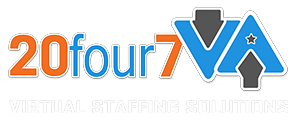Beyond Engagement: The Best Employee Retention Strategies for the Age of Remote Work

Long before “quiet quitting” was a social media buzzword, burnout culture had been driving employees to silently disengage from their work and seek alternative opportunities. Nowadays, organizations recognize the urgent need to go above and beyond when adopting the best employee retention strategies.
And in an age where remote work is widely adopted, business leaders and human resource management experts have an added challenge: keeping teams engaged even when they’re not physically together. Improving efforts on employee retention can help reduce employee turnover, improve employee satisfaction rates, and build a more resilient workforce overall. Here are some strategies on how to retain remote employees.
Seven Characteristics of a Resilient Remote Team
Companies that want to succeed in both the short and long term need to start working on creating a resilient remote team. Here are some signs that a remote workforce is able to thrive and achieve sustainable success:
-
An engaged workforce
Employee engagement is, perhaps, one of the biggest signs of having a resilient team. When everyone is on the same page, organizations see better results across the board.
Businesses must recognize the big role employee engagement plays in their success. Without it, they will struggle to retain employees. And as Angele Ventugol Onyie, CEO of Gabriel Global Consulting, explains, “We can’t afford to lose them [employees]. We want them to stay with us.” Angele and his company are in it for the long haul. They’re searching for long-term partnerships with employees, which requires some of the best employee retention strategies.
-
High employee job satisfaction
Employee satisfaction can be difficult to measure, but metrics like employee turnover rates, absenteeism rates, and even reviews on third-party websites like Glassdoor are good indicators of an organization’s ability to motivate and retain its workers.
Various factors influence employee motivation and satisfaction, but according to a Houston University study, the top drivers include:
- Compensation and promotions
- Relationships with colleagues
- Relationships with immediate superiors or managers
- Job security
- Paid holidays
- Work environment
If organizations want to start retaining remote employees, then these should be at the top of their list for things to improve upon.
-
Goal-oriented
Resilient teams have clear and actionable goals. Every member knows their roles and KPIs (Key Performance Indicators). They are properly equipped to sustainably achieve their individual and team goals, meaning it doesn’t come at the expense of work-life balance or the employees’ well-being.
Staying aligned on company and individual KPIs is important in making sure issues like job creep or redundant work processes are. It also helps give teams and employees a sense of accountability and ownership for their deliverables.
How do you set and monitor a remote assistant’s KPIs? Plus, more virtual staffing tips!

-
Collaborative
A resilient remote team is one that is collaborative and works together to achieve clearly set goals. Team members and leaders recognize the importance of embracing diverse points of view and sharing knowledge within and across teams.
In a resilient team, there is respect and support for everyone. Everyone feels safe to voice their opinions without judgment or fear. They know the importance of teams coming together to come up with creative solutions to various problems.
-
Excellent communicators
It goes without saying that communication is key to any successful team, and this is especially true for those who are not in the same physical space. A company culture that establishes clear communication lines can ensure smoother workflows and teams working in sync rather than in competition.
Aside from working teams communicating openly with each other, management should also be actively listening to what their employees have to say. Improving communication across an organization, which is one of the best employee retention strategies, can help improve employee morale and boost employee retention rates.
-
Growth seekers
Resilient teams don’t settle on being good. Instead, they do what they can to do better. Leaders of great remote teams value growth and career development. For new hires, they ensure that proper onboarding is done. The new employee is introduced to the working teams, has a one-on-one with their immediate superior, and is trained on the company’s processes and systems. They know the value of setting employees up for success in their new job and how it can impact the business and the employee retention rate in the long run.
Additionally, they encourage and support current employees’ growth. They provide the right resources like training, educational materials, and newsletters. These resources can help develop skills, acquire new skills, and improve employees’ physical and mental health.
-
Overall positive workplace culture
Another excellent sign of a thriving remote team is the sense of an overall positive workplace culture. The organization values the importance of a work environment in which employees feel valued, respected, and appreciated. A positive work environment can increase employee engagement, motivation, and satisfaction. All in all, a truly positive company culture can increase the possibility of retaining the best employees, securing business productivity, and overall business success.

Best Employee Retention Strategies: The Key to More Resilient Remote Teams
An effective retention strategy can be the missing piece your organization needs to thrive despite the varied internal and external challenges that can come your way.
Thorough Recruitment Process
Every successful employee retention strategy should start at the very beginning: talent acquisition. To ensure a positive employee experience, recruiters and hiring managers should not just hire what seems to be the top talent on paper. A proper screening and interview process can help determine whether a candidate is the best fit for the role and the organization.
A meticulous hiring process includes a clear job ad, relevant interview questions, and the right assessments. These allow both the company and the applicant to align on expectations and ensure a better employee experience. Getting it right in the beginning can help save both time and money. Whenever there’s a disconnect between what the employees expect or what they’re promised versus the reality of the work, there is a big chance that they will leave. This will restart the talent acquisition process, incurring additional expenses like labor and training costs.
Effective Onboarding Process
If new employees have a negative experience at the very beginning of their professional journey with our company, that can easily drive them to return to the job market. Since they’re new, they basically have zero engagement with their peers and managers yet. It means they’re more likely to seek out more compelling job opportunities and companies that can provide the support they need.
An effective onboarding process should equip your new hire with the right tools and information they need to hit the ground running. It should also provide:
- An overview of the company’s culture
- A proper introduction to their team or manager
- Training on policies and systems
Having a seamless onboarding process is one of the best employee retention strategies for any company. When executed well, your onboarding process can help build employee engagement and improve employee retention in the long run.
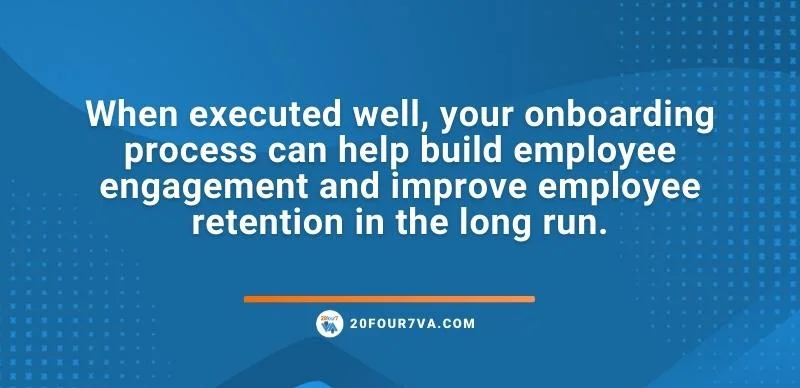
Set Clear Goals
Aligning goals and KPIs with employees is crucial in giving employees a sense of purpose. When they have the right information, like their accountabilities and responsibilities, they are in a better position to set boundaries at work, prioritize tasks, and manage their time better. Having something as seemingly simple as a “north star” can help boost employee productivity and is one of the best employee retention strategies.
Maintain Open Communication Channels
Another important part of the employee retention strategy is keeping communication channels open and working. It’s crucial for remote workers to feel part of the team just as much as onsite workers would. Communication channels should increase the visibility of remote workers so they are updated on company matters, possible career growth opportunities, and so on.
Companies don’t have to have multiple communication channels. It’s better to have a few tools that are effective to avoid confusion and messages literally getting lost in translation. Ensure that your business has the right combination of synchronous and asynchronous communication tools. These include apps like Slack, MS Teams, Skype, and the like.
And because water cooler talk is not possible when working remotely, organizations should try to cultivate informal interactions. This can be done by hosting virtual coffee breaks or online team bonding activities. These activities don’t need to be highly structured. It should encourage more comfortable conversations between work peers and managers alike.
Be Digital-Ready
Before transitioning to a hybrid or fully remote business, it’s crucial to ensure your company is ready to operate as such. Having the right systems will help level the playing field. Remote employees have as much visibility and potential to grow their careers as those working in the office.
It also ensures that the team will operate seamlessly wherever the members are. Employees should have the right tools to accomplish their work remotely. Failing to set up the right systems is like setting employees up for failure.
Protect Employee Well-being
An organization’s health and safety protocols should go beyond the four walls of the office, especially when you have remote employees. This is another essential part of effective employee retention. When your employees are in their best state, they can perform better and live more holistic lives. If you want to reach business goals sustainably, then promoting a healthy work-life balance and protecting employees’ well-being is key.
It’s important that organizations keep an eye on the well-being of their employees, especially since working from home can be more challenging for certain individuals. Regular check-ins and feedback sessions help ensure that members feel connected, heard, and supported. Here are other employee wellness projects that you can include in your employee retention strategies:
- Medical insurance coverage
- Mental health support programs
- Stress relief initiatives (yoga, guided meditation, etc.)
- Financial Wellness Benefits for Employees
- Wellness challenges
- Health and fitness programs (e.g., discounted or free gym class passes, gym membership)
- Resources (e.g., newsletters, HR reminders)
- Wellness and sick days allocation
- And so on
Train Leaders, Not Bosses
Have you ever heard of the saying, “Employees quit their boss, not their jobs,” before? While there are many factors that lead to resignations (e.g., inadequate salary, poor job fit, etc.), it is true that a lot of employees leave because of their boss, whether directly or indirectly. Management does play a crucial role in building a positive company culture that will make employees feel engaged and motivated to do their best.
Training managers to improve and apply their leadership skills should be an important part of effective employee retention efforts. Managers should be taught the basics of good communication, how to better recognize and reward employees for their work, and how to foster trust and collaboration among team members.
Steve Ramerini, Lead Visionary and CEO of COMPEL CEOs believes that leaders “must set the tone and keep the culture. They must effectively state and communicate their cause to attract and motivate followers.” This is why leadership trainings are important. Not all managers readily have the skills to accomplish these crucial leadership roles, but those who are willing can learn through proper training and mentoring.
Build a Solid Rewards and Recognition Program
Aside from competitive pay, a solid rewards and recognition program annual performance should not be absent from the best employee retention strategies. And this doesn’t refer to the annual performance review, although it is a part of the whole program. It means celebrating wins publicly and rewarding top performers.
Publicly Celebrating Employees
Publicly recognizing wins and achievements is essential in making valuable employees feel important. It’s also a way to show that the organization is serious about giving credit where credit is due.
An example of how to do this on a bigger scale is Dream Local Digital’s portal. It allows not just managers but also employees to sing praises of their teammates and celebrate wins with other employees in the company. The platform is also an excellent channel to share ideas and industry news and simply let employees engage with each other even when in a remote workplace environment. It can help employees interact with people they may not usually work with.
Rewarding Excellence
Recognizing high performers publicly and internally is one thing. But rewards are just as crucial. Rewarding high performers is crucial because it creates motivation and encourages employees to strive for excellence, knowing their hard work is thoroughly recognized and rewarded. It also serves as a form of recognition from the company, showing appreciation through something tangible.
To give you an idea of possible rewards to give to high performers, here are some examples from Gabriel Global Consulting CEO Angele Ventugol Onyie:
- Salary increase
- Additional paid time off
- Opportunity to grow
- Awards
- Coupons for weekends with loved ones
Prioritize Professional Development
Employees are more likely to stay with an employer that can shows them that they’re a part of the business’ future. This means prioritizing professional growth where employees are supported with the right training and resources to learn new skills or develop new ones. To add, training employees can also help the company since they’ll have more knowledgable subject matter experts in their workforce.
Retaining remote workers and helping them with their professional career development are great ways to improve your team’s productivity. Rather than a standardized career trajectory, Shannon Kinney, Founder and Client Success Officer of Dream Local Digital, shares that they “focus on building on [individual] employee strengths and goals.” This includes letting managers develop growth plans with each team member, giving them a more active role in crafting their career paths.
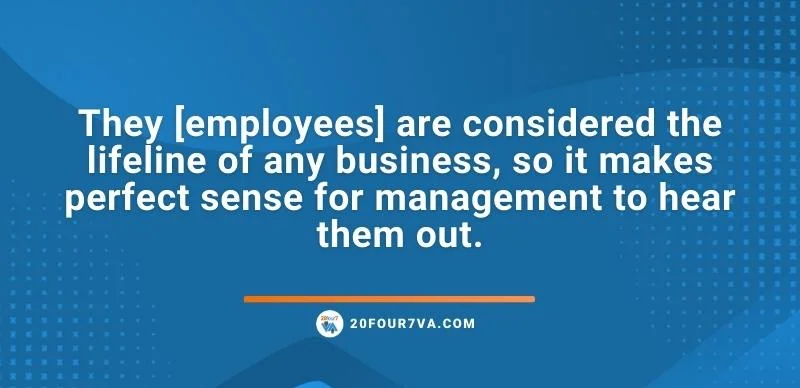
Solicit Employee Feedback
Employee feedback can help take your employee retention strategy to the next level. So often, these strategies are made by management. But injecting feedback from people directly affected by such initiatives can provide a different perspective. Additionally, even a departing employee can offer significant insights. They may not be able to stick with your company anymore, but they can help you make the necessary adjustments to improve the experience of remaining employees.
Soliciting employee feedback is crucial to Dream Local Digital’s employee retention strategies. According to Founder Shannon Kinney, they gather (and provide) feedback through various means, including:
- regular reviews one-on-one with a manager
- small, weekly team check-ins
- conducting surveys
It’s important to make employees feel valued and heard. They are considered the lifeline of any business, so it makes perfect sense for managers to hear them out. They can provide actionable insights on how business can improve their business operations as well as employee experience. This means enhancing a professional environment that can lead to more satisfied employees.
Why Work with Remote Teams?
Here are some of the top reasons why a lot of companies have opted to adopt fully or partially remote work setups for the foreseeable future:
-
Potential Cost-Savings
Of course, working remotely may not work for all industries. But a lot of businesses choose a remote setup for its potential cost-savings. Whether it’s a fully remote or hybrid setup, there’s a big chance that companies won’t need the same-sized office space as a fully onsite business. This can help reduce overhead costs, including rental and utility expenses.
Businesses can save even more by combining in-house staff with remote assistants (also called virtual assistants or VAs). Virtual assistants can support businesses on various parts of their operations, from routine administrative tasks to more specialized functions like marketing or telehealth. Hiring remote assistants helps teams manage their workload and improve productivity at a fraction of the cost.
Thinking of hiring remote assistants for your business? Book a free consultation with our Growth Experts and learn more about 20four7VA’s cost-effective remote staffing solutions!
-
Flexibility
While the jury is still out about the correlation between work-life balance and a fully remote setup, it’s clear that a majority of workers appreciate the flexibility that a flexible remote staffing setup can offer. Eliminating the need for long hours on the road driving or commuting gives workers more time to focus on other aspects of their lives. There are also employees who have relocated thanks to remote work: from those who choose to be closer to home or who simply want to say goodbye to the high costs of city living.
Additionally, flexibility in terms of where and when employees work is one of the growing demands of today’s workforce. So for companies who want to attract top talent and retain employees, offering the possibility of a flexible remote work setup can help turn the tides in their favor.
-
Productivity
Not everyone favors the traditional 9-to-5 office schedule. And with a more flexible remote work setup, workers can seek career opportunities that allow them to work during their peak productivity hours. They can also build a workspace that is the most suitable for them, limiting distractions and improving their sense of focus.
For example, an employee who lives in Asia prefers to work within EST work windows may apply for a role in companies on the East Coast or an employer who allows flexible schedules. The employee can get work that fits the best with their lifestyle and most productive hours. At the same time, employers get to hire motivated and highly productive workers that deliver the best results.
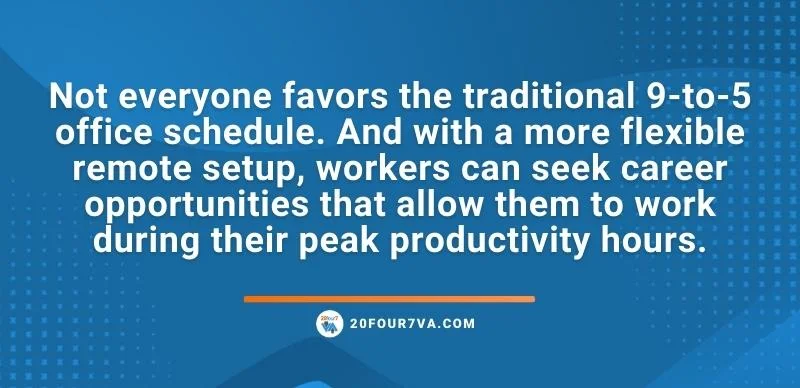
-
Wider Talent Pool
Hiring remote workers can open up a business to a bigger talent pool. They can get the best candidates for the role regardless of their location, gender, etc. Rather than geographical considerations, the deciding factors are their skills and job fit—both are crucial in ensuring high employee retention rates.
A wider talent pool can also mean increasing a team’s diversity and inclusivity. These are known to help build a more embracing and collaborative corporate culture. Additionally, having a diverse workforce can help find creative solutions. The team can consider points of view and approaches to find the most suitable way out of a problem.
-
Business Continuity
Flexible remote staffing can help to ensure business continuity in many ways. One of the most important is the ability to work from any location, which reduces the possibility of a local crisis or disaster disrupting operations.
Remote teams also have the benefit of being able to access cloud-based systems and tools, which can ensure that data and documents are accessible and secure wherever the workers are. This requires companies to invest in digitalization and securing their systems, allowing for more seamless and secure business operations.
Build your own remote team or team of virtual assistants! Contact our Growth Experts today to get a custom-fit staffing solution.
In summary
Working with a remote team offers many benefits to a business, from saving on costs to improving productivity. However, this relatively new work setup can be challenging for some organizations to manage and develop. Hopefully, these best employee retention strategies can help your business build resilient teams with highly engaged employees. This type of team will help you achieve goals and thrive even in the most unfavorable of business circumstances.
Are you ready to scale your business with a remote team? Schedule a no-obligation consultation with our Growth Experts to learn more about the right remote staffing solutions for your business.
